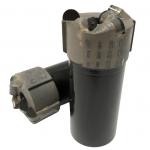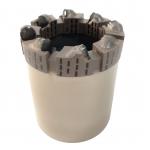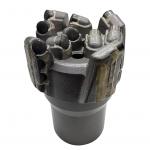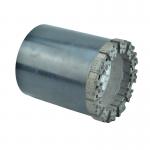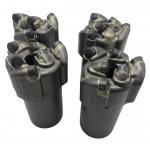Reduced Stickiness in Clay-rich Formations Optimal Flow Rate
Distribution PDC Drill Bit Some more details on drilling and PDC (Polycrystalline Diamond
Compact) drill bits: PDC Bit Sizing: PDC drill bits are available in various sizes to
accommodate different wellbore diameters and drilling requirements.
The bit size is determined by the outer diameter (OD) of the bit.
Common PDC bit sizes range from a few inches to several feet in
diameter. The selection of the appropriate bit size depends on
factors such as the wellbore size, casing program, drilling
objectives, and equipment capabilities. PDC Bit Hydraulics: Hydraulic performance is a critical aspect of
PDC bit design. Proper hydraulics ensure efficient cuttings
removal, cooling of the bit, and overall drilling stability. The
design of the bit's hydraulic system includes the placement, size,
and orientation of the nozzles or jet channels. Optimized
hydraulics prevent bit balling, maintain good hole cleaning, and
minimize the risk of bit damage or failure. PDC Bit Connection Types: PDC drill bits are connected to the
drillstring using various types of connections. The choice of
connection depends on factors such as the drilling rig equipment,
operating conditions, and the desired level of torque transmission.
Common connection types for PDC bits include threaded connections
(such as API connections), weld-on connections, and direct
connections (where the bit is integrated with the bottomhole
assembly). PDC Bit Applications: PDC drill bits are used in a wide range of
drilling applications across different industries. They are
commonly employed in oil and gas exploration and production,
geothermal drilling, mining operations, and directional drilling.
PDC bits are suitable for drilling through various formations,
including soft formations (such as clay and shale) and hard
formations (such as limestone, sandstone, and granite). PDC Bit Cost Considerations: The cost of PDC drill bits can vary
depending on factors such as the bit size, design complexity,
cutter quality, and the manufacturer. While PDC bits may have a
higher upfront cost compared to other types of drill bits, they can
offer advantages such as increased drilling efficiency, longer run
life, and improved overall performance. The cost-effectiveness of
PDC bits is evaluated based on factors such as drilling speed,
durability, and the total cost of drilling operations. PDC Bit Environmental Considerations: Environmental considerations
are important in drilling operations, and PDC drill bits can
contribute to environmentally friendly practices. PDC bits are
designed to minimize cuttings generation, which can reduce the
volume of drilling waste generated during operations. Efficient
drilling with PDC bits can also help reduce the overall
environmental footprint by reducing the time required for drilling
and minimizing the disturbance of natural habitats. PDC Bit Limitations: While PDC drill bits offer many advantages,
they do have certain limitations. PDC bits may be less effective in
drilling through highly abrasive formations or formations with high
compressive strengths. In such cases, diamond-enhanced or hybrid
bits may be considered. PDC bits also have a reduced ability to
withstand impact loading compared to roller cone bits. Careful
selection and optimization of the bit design are necessary to
mitigate these limitations and maximize performance. PDC Bit Maintenance: Proper maintenance of PDC drill bits is
essential to ensure optimal performance and longevity. Regular
inspections, cleaning, and repair of the bit are conducted to
address issues such as cutter wear, damage, or bit body integrity.
Some operators employ specialized bit maintenance facilities or
services to extend the life of their PDC bits and minimize downtime
associated with bit replacements. Emerging Technologies: The drilling industry continues to explore
and develop new technologies to enhance PDC drill bit performance.
Advancements include the use of artificial intelligence and machine
learning algorithms to optimize drilling parameters, the
integration of sensors for real-time downhole monitoring and
diagnostics, the development of advanced cutter materials with
improved properties, and the application of nanotechnology to
enhance the performance of PDC bits in challenging drilling
environments. PDC Bit Research and Development: Ongoing research and development
efforts focus on advancing PDC bit technology to address industry
challenges and improve drilling efficiency. Research institutions,
drilling companies, and manufacturers collaborate to study factors
such as cutter performance, bit design optimization, wear
mechanisms, and the development of new materials. These efforts
contribute to the continuous evolution and improvement of PDC drill
bits.
These additional details provide a deeper understanding of various
aspects related to PDC drill bits and drilling operations. Stay
up-to-date with industry advancements and consult with drilling
experts and manufacturers for the latest information on PDC bit. FAQ: 1 Can PDC bits be used for drilling in sandy shale formations?
A: PDC bits can be used for drilling in sandy shale formations.
However, designs that prevent bit balling and ensure efficient
cuttings removal are crucial. . Q: Can PDC bits be used for drilling in limestone with marl
interbeds formations?
A: PDC bits can be used for drilling in limestone with marl
interbeds formations. However, designs that address the varying
rock types and provide efficient cuttings removal are important. 3. Q: Can PDC bits be used for drilling in basalt with vesicular
zones formations?
A: PDC bits can be used for drilling in basalt with vesicular zones
formations. However, cutter selection and bit design should
consider the presence of vesicles and potential bit damage. 4. Q: Can PDC bits be used for drilling in clay-rich sand
formations?
A: PDC bits can be used for drilling in clay-rich sand formations.
However, designs that prevent bit balling and ensure efficient
cuttings removal are crucial. 5. Q: Can PDC bits be used for drilling in limestone with shale
interbeds formations?
A: PDC bits can be used for drilling in limestone with shale
interbeds formations. However, designs that address the varying
rock types and provide efficient cuttings removal are important. |
